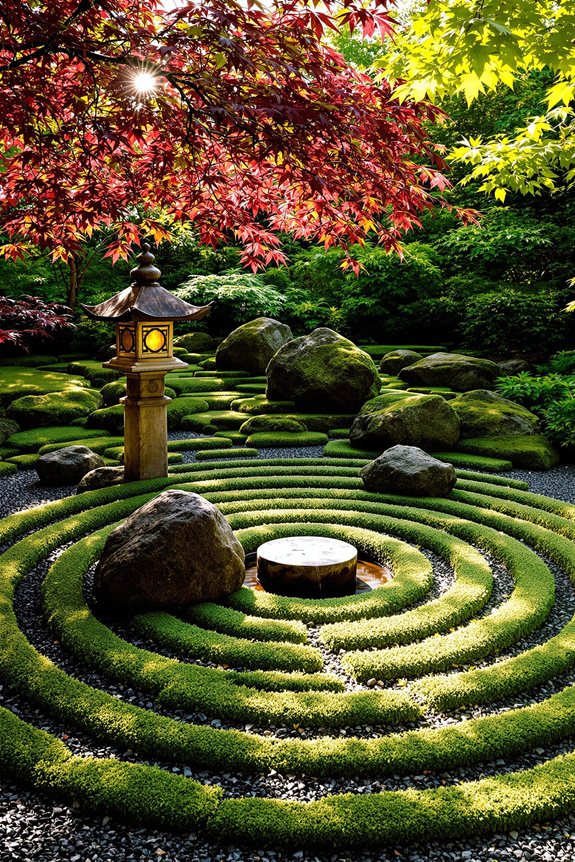Transform your outdoor space into a peaceful Zen garden with three crucial tips. Start by selecting and arranging local volcanic or sedimentary rocks in asymmetrical groups of three or five, creating natural focal points. Next, incorporate calming water features like recirculating fountains near seating areas to improve tranquility. Ultimately, use light-colored gravel raked in concentric patterns to represent flowing water, while positioning elements thoughtfully for peak flow and balance. These fundamental principles open the door to deeper Zen garden mastery.
Key Takeaways
- Create asymmetrical arrangements of local rocks in groups of three or five to establish natural balance and visual interest.
- Install calming water features near seating areas with recirculating fountains for a tranquil atmosphere and soothing sounds.
- Use light-colored gravel raked in concentric circles to represent flowing water and create a sense of movement.
- Choose just 2-3 native plant species and maintain their natural shapes through careful pruning for minimalist aesthetics.
- Design meandering pathways with warm LED lighting to avoid rigid lines and ensure natural flow throughout the space.
Creating Balance With Natural Elements
While creating a Zen garden requires careful consideration of multiple elements, achieving visual harmony begins with the thoughtful placement of natural materials.
Start by selecting local volcanic or sedimentary rocks that'll anchor your design, arranging them in groups of three or five to align with traditional principles of asymmetry.
Complement your rock arrangements with thoughtfully placed water features, like a small recirculating fountain or shallow stone basin (tsukubai).
You'll find that strategic positioning near seating areas boosts the tranquil sounds while maintaining balance.
Remember to incorporate light-colored gravel around these elements, which reflects sunlight and creates an improved sense of spaciousness.
Essential Design Elements for Zen Spaces
Although creating a serene Zen garden may seem daunting initially, mastering five essential design elements will help you craft an authentic meditation space.
Begin with calming water features like small ponds or subtle fountains that mask external noise while conserving resources through recirculating systems.
Embrace minimalist plants by selecting just 2-3 native species, such as bamboo or moss, and maintain their natural shapes through thoughtful pruning.
You'll want to position elements asymmetrically, using odd-numbered groupings of rocks and meandering pathways that avoid rigid lines.
Create dedicated meditation zones with low benches at 16-18 inches high, surrounded by natural barriers, and illuminate your space with warm LED lighting placed strategically along paths.
Mindful Material Selection and Placement
Building on the design fundamentals, thoughtful material selection stands as the cornerstone of an authentic Zen garden's serenity. When selecting materials, you'll want to focus on stone textures that evoke natural geological formations while creating gravel patterns that mimic water's flow.
| Material | Purpose | Placement | Maintenance |
|---|---|---|---|
| River Stones | Anchor Design | Rear Garden | Monthly Clean |
| Fine Gravel | Water Pattern | Base Layer | Weekly Rake |
| Moss | Green Texture | Shaded Areas | Monthly Trim |
| Bamboo | Vertical Interest | Borders | Seasonal Cut |
Position your largest stones initially, burying 20-30% underground for stability, and rake your gravel in concentric circles to achieve that coveted sense of movement and flow.
Conclusion
Recall that you're creating more than just a garden – you're designing a sacred space for meditation and inner peace. By thoughtfully incorporating natural elements, following crucial zen principles, and selecting materials mindfully, you'll craft an environment that nurtures tranquility. While your zen garden will evolve with the seasons, its core purpose remains constant: offering you a personal sanctuary where you can reconnect with nature and yourself.

